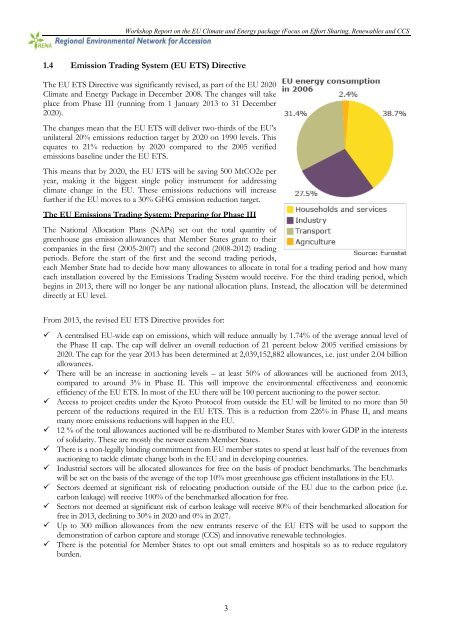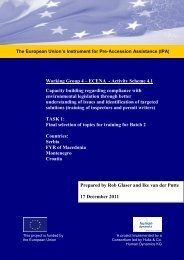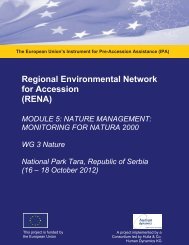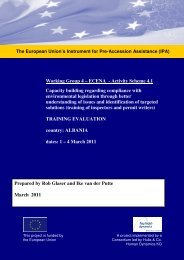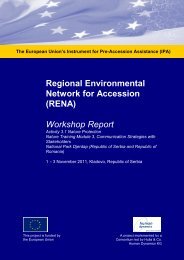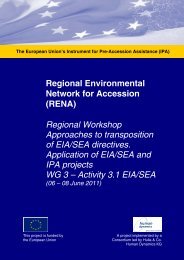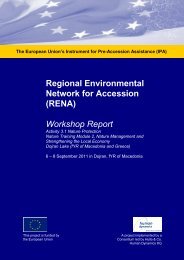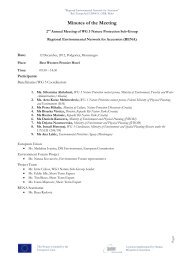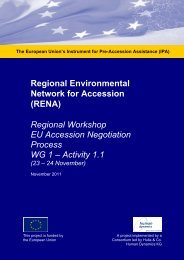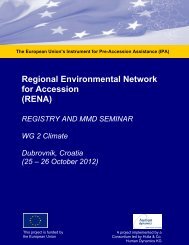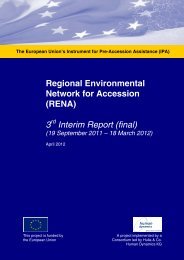Workshop Report March 2011 Budva ... - Renanetwork.org
Workshop Report March 2011 Budva ... - Renanetwork.org
Workshop Report March 2011 Budva ... - Renanetwork.org
- No tags were found...
Create successful ePaper yourself
Turn your PDF publications into a flip-book with our unique Google optimized e-Paper software.
<strong>Workshop</strong> <strong>Report</strong> on the EU Climate and Energy package (Focus on Effort Sharing, Renewables and CCS1.4 Emission Trading System (EU ETS) DirectiveThe EU ETS Directive was significantly revised, as part of the EU 2020Climate and Energy Package in December 2008. The changes will takeplace from Phase III (running from 1 January 2013 to 31 December2020).The changes mean that the EU ETS will deliver two-thirds of the EU’sunilateral 20% emissions reduction target by 2020 on 1990 levels. Thisequates to 21% reduction by 2020 compared to the 2005 verifiedemissions baseline under the EU ETS.This means that by 2020, the EU ETS will be saving 500 MtCO2e peryear, making it the biggest single policy instrument for addressingclimate change in the EU. These emissions reductions will increasefurther if the EU moves to a 30% GHG emission reduction target.The EU Emissions Trading System: Preparing for Phase IIIThe National Allocation Plans (NAPs) set out the total quantity ofgreenhouse gas emission allowances that Member States grant to theircompanies in the first (2005-2007) and the second (2008-2012) tradingperiods. Before the start of the first and the second trading periods,each Member State had to decide how many allowances to allocate in total for a trading period and how manyeach installation covered by the Emissions Trading System would receive. For the third trading period, whichbegins in 2013, there will no longer be any national allocation plans. Instead, the allocation will be determineddirectly at EU level.From 2013, the revised EU ETS Directive provides for: A centralised EU-wide cap on emissions, which will reduce annually by 1.74% of the average annual level ofthe Phase II cap. The cap will deliver an overall reduction of 21 percent below 2005 verified emissions by2020. The cap for the year 2013 has been determined at 2,039,152,882 allowances, i.e. just under 2.04 billionallowances. There will be an increase in auctioning levels – at least 50% of allowances will be auctioned from 2013,compared to around 3% in Phase II. This will improve the environmental effectiveness and economicefficiency of the EU ETS. In most of the EU there will be 100 percent auctioning to the power sector. Access to project credits under the Kyoto Protocol from outside the EU will be limited to no more than 50percent of the reductions required in the EU ETS. This is a reduction from 226% in Phase II, and meansmany more emissions reductions will happen in the EU. 12 % of the total allowances auctioned will be re-distributed to Member States with lower GDP in the interestsof solidarity. These are mostly the newer eastern Member States. There is a non-legally binding commitment from EU member states to spend at least half of the revenues fromauctioning to tackle climate change both in the EU and in developing countries. Industrial sectors will be allocated allowances for free on the basis of product benchmarks. The benchmarkswill be set on the basis of the average of the top 10% most greenhouse gas efficient installations in the EU. Sectors deemed at significant risk of relocating production outside of the EU due to the carbon price (i.e.carbon leakage) will receive 100% of the benchmarked allocation for free. Sectors not deemed at significant risk of carbon leakage will receive 80% of their benchmarked allocation forfree in 2013, declining to 30% in 2020 and 0% in 2027. Up to 300 million allowances from the new entrants reserve of the EU ETS will be used to support thedemonstration of carbon capture and storage (CCS) and innovative renewable technologies. There is the potential for Member States to opt out small emitters and hospitals so as to reduce regulatoryburden.3


